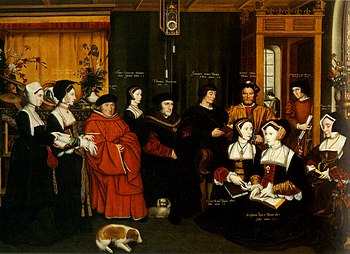
Hans Holbein the Younger was a German-Swiss painter and printmaker who worked in a Northern Renaissance style, and is considered one of the greatest portraitists of the 16th century. He also produced religious art, satire, and Reformation propaganda, and he made a significant contribution to the history of book design. He is called "the Younger" to distinguish him from his father Hans Holbein the Elder, an accomplished painter of the Late Gothic school.

Elizabeth Seymour was a younger daughter of Sir John Seymour of Wulfhall, Wiltshire and Margery Wentworth. Elizabeth and her sister Jane served in the household of Anne Boleyn, the second wife of Henry VIII. The Seymours rose to prominence after the king's attention turned to Jane. In May 1536, Anne Boleyn was accused of treason and adultery, and subsequently executed. On 30 May 1536, eleven days after Anne's execution, Henry VIII and Jane were married. Elizabeth was not included in her sister's household during her brief reign, although she would serve two of Henry VIII's later wives, Anne of Cleves and Catherine Howard. Jane died 24 October 1537, twelve days after giving birth to a healthy son, Edward VI.

Nostell Priory is a Palladian house in Nostell, West Yorkshire, England, near Crofton on the road to Doncaster from Wakefield. It dates from 1733, and was built for the Winn family on the site of a medieval priory. The Priory and its contents were given to the National Trust in 1953 by the trustees of the estate and Rowland Winn, 3rd Baron St Oswald.

William Larkin was an English painter active from 1609 until his death in 1619, known for his iconic portraits of members of the court of James I of England which capture in brilliant detail the opulent layering of textiles, embroidery, lace, and jewellery characteristic of fashion in the Jacobean era, as well as representing numerous fine examples of oriental carpets in Renaissance painting.

Rowland Lockey was an English painter and goldsmith, and was the son of Leonard Lockey, a crossbow maker of the parish of St Bride's, Fleet Street, London. Lockey was apprenticed to Queen Elizabeth's miniaturist and goldsmith Nicholas Hilliard for eight years beginning Michaelmas 1581 and was made a freeman or master of the Worshipful Company of Goldsmiths by 1600.

The artists of the Tudor court are the painters and limners engaged by the monarchs of England's Tudor dynasty and their courtiers between 1485 and 1603, from the reign of Henry VII to the death of Elizabeth I.
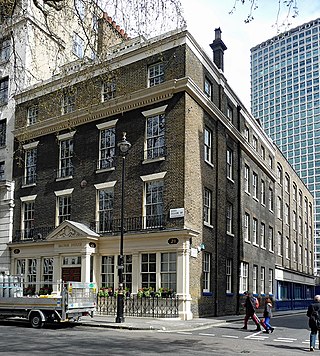
Manor House, 21 Soho Square is a Grade II listed building in the West End of London. It has 17th-century origins but the existing structure dates from 1838. It was originally built in 1678 as a townhouse but through its history has also been a notorious brothel, the headquarters of Crosse & Blackwell and is now an office building.

Catherine Howard, also spelt Katheryn Howard, was Queen of England from 1540 until 1541 as the fifth wife of King Henry VIII. She was the daughter of Lord Edmund Howard and Joyce Culpeper, a cousin to Anne Boleyn, and the niece of Thomas Howard, 3rd Duke of Norfolk. Thomas Howard was a prominent politician at Henry's court, and he secured her a place in the household of Henry's fourth wife, Anne of Cleves, where she caught the King's interest. She married him on 28 July 1540 at Oatlands Palace in Surrey, just 19 days after the annulment of his marriage to Anne. He was 49, and she was between 15 and 21 years old, though it's widely accepted that she was 17 at the time of her marriage to Henry VIII.

Portrait of Sir Thomas More is an oak panel painting commissioned in 1527 of Thomas More by the German artist and printmaker Hans Holbein the Younger, now in the Frick Collection in New York.
The Lenthall pictures were a number of paintings owned by the Lenthall family and housed at Burford Priory. The collection was publicly commented on by art historians and tourists. It was largely dispersed in two sales in 1808 and 1833, although some works were retained by the family and sold in the late 20th century.
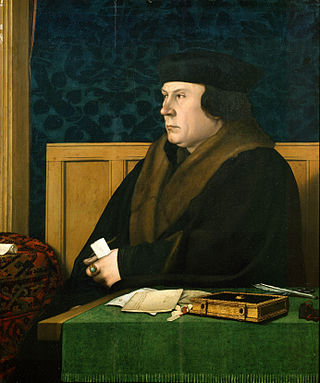
Portrait of Thomas Cromwell is a small oil painting by the German and Swiss artist Hans Holbein the Younger, usually dated to between 1532 and 1534, when Cromwell, an English lawyer and statesman who served as chief minister to King Henry VIII of England from 1532 to 1540, was around 48 years old. It is one of two portraits Holbein painted of him; the other is a tondo from a series of medallions of Tudor courtiers.
The Petre Family pictures were a collection of portraits and other paintings housed at Ingatestone Hall and Thorndon Hall. The pictures were initially displayed in the long gallery at Ingatestone Hall. By 1600 the displayed paintings included a portrait of William Petre which remains at Ingatestone Hall. At that time it was the only family portrait on display.
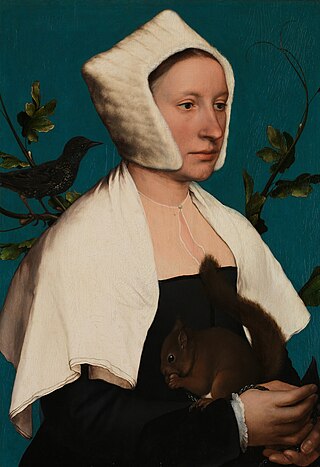
Portrait of a Lady with a Squirrel and a Starling is an oil-on-oak portrait completed in around 1526–1528 by German Renaissance painter Hans Holbein the Younger. The painting shows a demurely dressed young woman sitting against a plain blue background and holding in her lap a squirrel on a chain eating a nut; a starling sits on a grape vine in the background with its beak pointing at her right ear. The grape, a Biblical motif, for Holbein was a symbol of abundance and wealth. The subject of this portrait is believed to be Anne Lovell, wife of Sir Francis Lovell (d. 1551), an Esquire of the Body to Henry VIII.
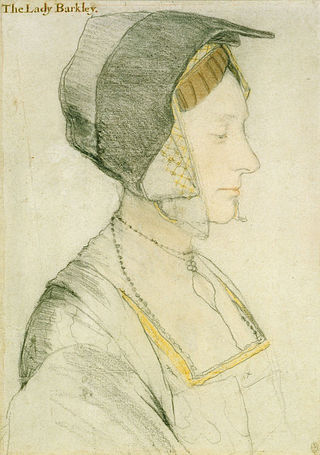
Elizabeth Dauncey, one of Thomas More's children, was part of a circle of exceptionally educated and accomplished women who exemplified "learned ladies" for the next two centuries.

Cecily Heron, one of Thomas More's children, was part of a circle of exceptionally educated and accomplished women who exemplified "learned ladies" for the next two centuries.

The Schwarzwald family was a wealthy, patrician, merchant family living in the Hanseatic city of Danzig (Gdańsk) from the 15th to the 18th century. The family, which had its origins in the Black Forest in south-west Germany, can be traced back to Georg von Schwarzwald, who settled in Danzig in the early 1400s.

Portrait of a Lady, probably a Member of the Cromwell Family is an oil on panel portrait completed in around 1535–1540 by German painter and printmaker, Hans Holbein the Younger. The painting shows an elegantly but demurely dressed young woman sitting against a blue-grey background. The subject of this portrait is thought to be a member of the Cromwell family, perhaps Thomas Cromwell's daughter-in-law, Elizabeth Seymour, sister to Jane, third consort of Henry VIII.

Portrait Miniature of Hans Schwarzwaldt is a watercolour on vellum portrait completed in around 1535–1540 by German artist and printmaker, Hans Holbein the Younger. The painting shows a young man against a clear blue background. Only the head and shoulders are shown, turned three-quarters to the viewer's right, the eyes cast down. The light brown hair is close cropped, and the sitter is wearing a brown doublet, trimmed with black, with a small, open falling collar with white strings attached. There is no inscription. The subject of this portrait was identified as a Danzig merchant, Hans Schwarzwaldt (1513-1575), based on a very strong resemblance to another portrait made by Holbein in 1543, but his age does not match the inscription. It has been suggested that the young man might be Gregory Cromwell, 1st Baron Cromwell, the son of Henry VIII's chief minister, Thomas Cromwell, 1st Earl of Essex.
